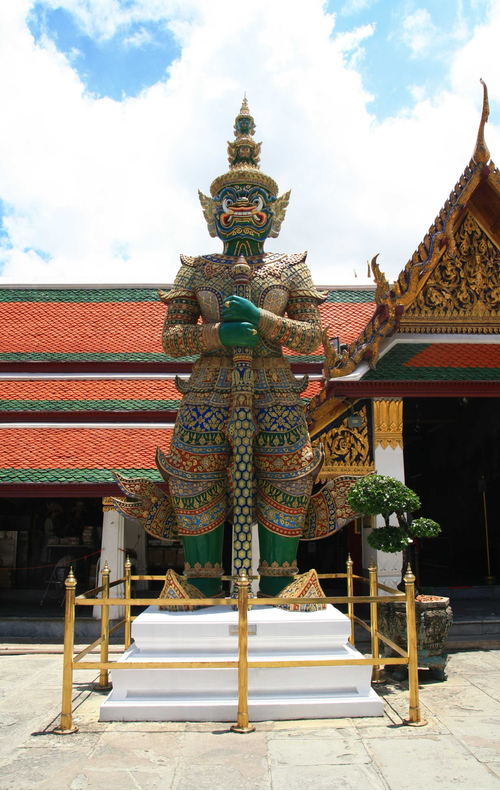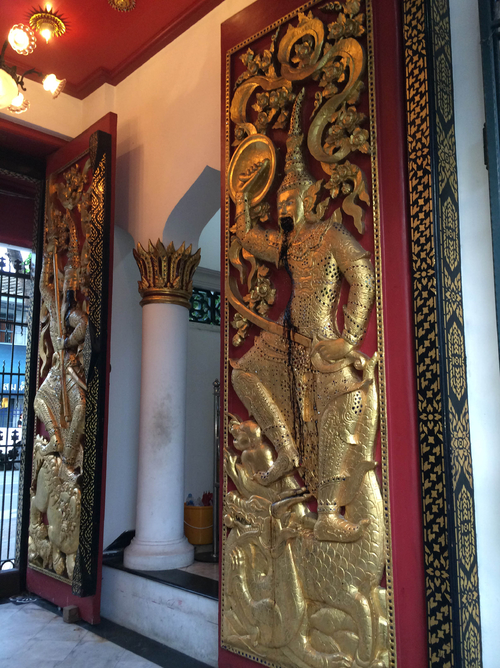ค้นหางานศิลปกรรม
ฐานข้อมูลศิลปกรรมในเอเชียตะวันออกเฉียงใต้
ประติมากรรมยักษ์วัดพระแก้ว
ประติมากรรมรูปยักษ์ทั้ง 12 ตน ทำด้วยปูนปั้น เครื่องแต่งกายประกอบขึ้นจากกระเบื้องเคลือบสีต่างๆ ทำเป็นมงกุฎที่มียอดแตกต่างกันเช่นเดียวกับหัวโขน สวมเสื้อแขนยาว สนับเพลา ชายไหว รองเท้าปลายแหลม ลักษณะเดียวกับเครื่องแต่งกายโขน ระบายสีผิวพรรณแตกต่างกันโดยใช้สีเช่นเดียวกับหัวโขนของยักษ์แต่ละตน ยักษ์ทั้ง 6 คู่ ประกอบด้วยคู่ที่ 1. สุริยาภพ และอินทรชิต คู่ที่ 2. มังกรกัณฐ์ และวิรุฬหก คู่ที่ 3. ทศคีจันธร และทศคีรีวัน คู่ที่ 4. จักรวรรดิ์ และอัศกรรณมาราสูร คู่ที่ 5. ทศกัณฐ์ และสหัสสเดชะ คู่ที่ 6. ไมยราพ และวิรุฬจำบัง
ประติมากรรมประตูเสี้ยวกาง
ซุ้มประตูประกอบด้วยบานประตู 2 ชุด แต่ละชุดประกอบด้วยบานประตูสี่เหลี่ยมผืนผ้า 2 บาน พื้นสีแดง แต่ละบานสลักเป็นรูปทวารบาลอย่างจีนปิดทอง แต่งกายยืนเครื่องคล้ายทวารบาลแบบไทย ยืนเงื้อง่าถืออาวุธ ได้แก่ ง้าว ดาบ กริช โล่ อยู่บนหลังสัตว์ผสมต่างๆอย่างจีน รวมทั้งสิ้น 4 องค์ ที่ปากของทวารบาลแต่ละองค์แต่เดิมมีคราบยาฝิ่นสีดำติดอยู่เนื่องจากประชาชนทำมาป้ายถวายทวารบาล ในภายหลังได้มีการล้างทำความสะอาดคราบนั้นออก แต่ได้ทาสีดำไว้เพื่อแสดงถึงที่มาตามประวัติศาสตร์ ซึ่งลักษณะดังกล่าวเป็นเอกลักษณ์ของทวารบาลหรือเสี้ยวกางที่วัดบวรนิเวศวิหาร
จิตรกรรมทวารบาล ลายคำประดับผนังด้านในสิมวัดเชียงทอง
ในศิลปะล้านช้างสกุลช่างหลวงพระบาทราวพุทธศตวรรษที่ 25 การตกแต่งลายคำได้รับความนิยมอย่างมาก โดยส่วนมากมักประดับภายในอาคาร โดยผนังด้านหน้าวัดเชียงทอง มีการประดับภาพ “เหล่าเทวดากำลังบูชาพระเจดีย์จุฬามณี” อันงดงามมาก บริเวณผนังที่ขนาบทางเข้ายังปรากฏภาพ “ทวารบาล” หรือเทวดาผู้รักษาประตูขนาดใหญ่ เทวดาเหล่านี้มักถือดอกโบตั๋นอันสื่อความหมายถึง “การบูชาพระพุทธเจ้า” ผู้ประทับภายในอาคารนั้น ดอกโบตั๋นเป็นดอกไม้ในศิลปะจีนที่เข้ามามีบทบาททั้งในศิลปะล้านช้างและล้านนา
จิตรกรรมทวารบาลแบบจีน สิมวัดล่องคูณ
เนื่องจากศิลปะหลวงพระบางช่วงพุทธศตวรรษที่ 24 เป็นระยะที่ได้รับอิทธิพลรัตนโกสินทร์อย่างมาก ทำให้รูปทวารบาลแบบจีนตามพระราชนิยมในรัชกาลที่สามได้เข้ามาปรากฏในแถบนี้บางวัด เช่น วัดล่องคูณเมืองหลวงพระบาง เป็นต้น อนึ่ง ต้องไม่ลืมว่า การที่เจ้านายบางพระองค์ในราชวงศ์หลวงพระบางได้เคยเสด็จมาประทับ ณ กรุงเทพจึงอาจทำให้อิทธิพลรัตนโกสินทร์ปรากฏบทบาทอย่างมากในแถบนี้ก็ได้
ประติมากรรมทวารบาลจากปราสาทดงเดือง
ที่โคปุระของปราสาทมีทวารบาลประดิษฐานอยู่ ทวารบาลดังกล่าวแสดงท่าทางข่มขู่ ยกมือเงื้ออาวุธจะทำร้ายและมีหน้าตาดุร้าย ขาทั้งสองข้างยืนเหยียบอสูรดุร้ายอยู่ ท่าทางที่แสดงความดุร้ายข่มขู่เช่นนี้แสดงให้เห็นอิทธิพลของทวารบาลแบบจีน ในขณะเดียวกันการแต่งตัวของประติมากรรมกลับแสดงความเป็นพื้นเมืองดงเดือง อย่างมาก ทั้งในด้านมงกุฎซึ่งประดับด้วยตาบทรงพุ่มข้าวบิณฑ์ขนาดใหญ่ และการเปลือยท่อนบนและทรงผ้านุ่งก็ล้วนแต่แสดงความเป็นพื้นเมืองจาม
ประติมากรรมทวารบาลจากปราสาทดงเดือง
ที่โคปุระของปราสาทมีทวารบาลประดิษฐานอยู่ ทวารบาลดังกล่าวแสดงท่าทางข่มขู่ ยกมือเงื้ออาวุธจะทำร้ายและมีหน้าตาดุร้าย ขาทั้งสองข้างยืนเหยียบอสูรดุร้ายอยู่ ท่าทางที่แสดงความดุร้ายข่มขู่เช่นนี้แสดงให้เห็นอิทธิพลของทวารบาลแบบจีน ในขณะเดียวกันการแต่งตัวของประติมากรรมกลับแสดงความเป็นพื้นเมืองดงเดือง อย่างมาก ทั้งในด้านมงกุฎซึ่งประดับด้วยตาบทรงพุ่มข้าวบิณฑ์ขนาดใหญ่ และการเปลือยท่อนบนและทรงผ้านุ่งก็ล้วนแต่แสดงความเป็นพื้นเมืองจาม
ประติมากรรมทวารบาลหน้าตาดุร้าย
ทวารบาลองค์นี้เป็นประติมากรรมที่แสดงความเป็นพื้นเมืองดงเดืองอย่างมาก กล่าวคือ มีพระขนงตอเป็นปีกกา พระเนตรโปน พระโอษฐ์หนา พระนาสิกใหญ่ มีพระมัสสุ หน้าตาที่ดุร้ายของประติมากรมเชนนี้ย่อมแสดงให้เห็นว่าคงเคยเป็นทวารบาลมาก่อน มงกุฎซึ่งประดับด้วยตาบรูปพุ่มข้าวบิณฑ์ขนาดใหญ่จำนวนสามตาบนี้ถือเป็นลักษณะที่นิยมอย่างมากในศิลปะดงเดือง
ประติมากรรมทวารบาล
ประติมากรรมทวารบาล สลักเครื่องทรงอย่างเต็มที่ สวมกระบังหน้าและทำมวยผมเป็นทรงกระบอกตามรูปแบบของประติมากรรมในสมัยเมืองพระนคร มีการสวมเข็มขัดรูปวงโค้ง และ อุทรพันธะ (เข็มขัดคาดท้อง) นุ่งผ้าแบบสมพตสั้นมีการอัดพลีต มีการชักชายผ้านุ่งแบบชายผ้ารูปหางปลาชายเดียวด้านหน้าและชายพกด้านข้างแบบไม่เป็นธรรมชาติ ตามรูปแบบศิลปะสมัยเมืองพระนคร



